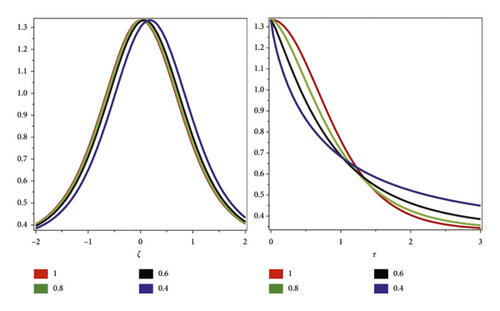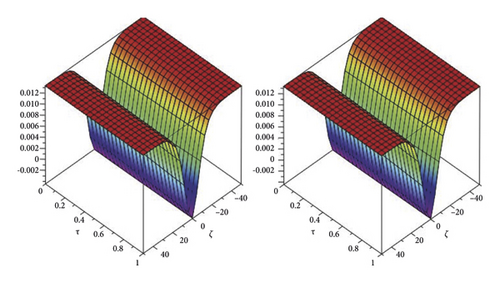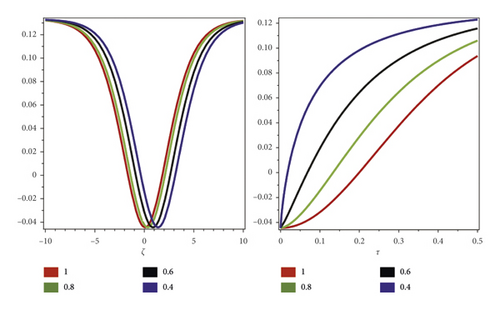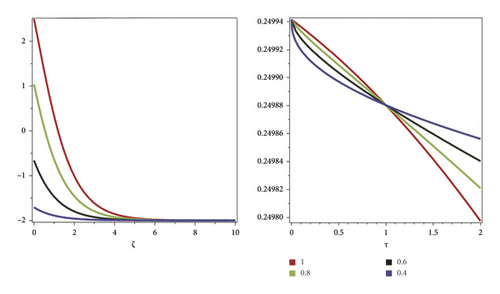Analysis of the Fractional-Order Kaup–Kupershmidt Equation via Novel Transforms
Abstract
In this article, we develop a technique to determine the analytical result of some Kaup–Kupershmidt equations with the aid of a modified technique called the new iteration transform method. This technique is a mixture of the novel integral transformation Elzaki transformation and the new iteration technique. The nonlinear term can be handled easily by a new iteration technique. The results show that the combination of the Elzaki transformation and the new iteration technique is quite capable and basically well suited for applying in such problems and that it can be implemented to other nonlinear models. This technique is viewed as an effective alternative approach to certain existing approaches for such accurate models.
1. Introduction
Fractional calculus is regarded as an important branch of science, particularly for phenomena that cannot be defined by basic nonlinear ordinary differential equations or partial differential equations with integer-order operators. The use of memory is one of the main advantages of fractional-order derivatives over standard derivatives. In recent years, there have been numerous applications of fractional-order ordinary and partial differential equations in many fields of physics and engineering. There have been several key works discovered, particularly in genetic mechanics and in the viscoelasticity concept, where fractional-order derivatives are utilized for a good explanation of the properties of materials. This is the main benefit of fractional derivatives compared with traditional integer-order models in which such effects are neglected. The computational modeling and analysis of structures and procedures, based on the explanation of their properties in concepts of fractional derivatives, obviously result in differential equations of fractional order and the requirement of finding solutions such as mathematical equations [1–10].
In 1980, Kaup [11] first introduced a significant dispersive basic Kaup–Kupershmidt equation, and then it was improved by Kupershmidt [12] in 1994. This study is concerned with the analysis of the modified fractional-order Kaup–Kupershmidt (KK) equation. In recent decades, excellent scientific work has been devoted to the analysis of the classical KK equation. The modern KK equation can be integrated at p = 5/2 [13] and is considered to have bilinear representation [14]. Soliton and solitary wave results can be obtained for general nonlinear development problems by importing four diverse techniques autonomously. Nonlaopon et al. [15] used the inverse scattering approach to establish soliton results to analyze nonlinear equations with physical implications. Two integrable differential-difference equations exhibit soliton solutions of the Kaup-Kupershmidt equation type [16]. Musette introduced the fifth-order KK equation, and Verhoeven was one of the combined instances of the Henon–Heiles method; see [17] for more details. Prakasha et al. [18] used the q-homotopy analysis transform method which is implemented to obtain the result for the fractional-order KK equation.
Daftardar-Gejji and Jafari [19] introduced a new iterative methodology for investigating nonlinear equations in 2006. Jafari [20] was the first to use the Laplace transform in an iterative technique. In [21], Jafari et al. suggested a modified straightforward methodology, named iterative Laplace transformation technique, to look for the numerical effects of the fractional partial differential equation system. Iterative Laplace transformation technique is used to solve linear and nonlinear partial differential equations such as time-fractional Zakharov–Kuznetsov equation [22], fractional-order Fokker–Planck equation [23], and Fornberg–Whitham equation [24].
This article modified the iterative method with the Elzaki transform; the novel approach is named the iterative transformation technique. The new iterative transformation technique is implemented to evaluate the fractional order of the system of the KK equation. The outcome of several illustrative cases is described to demonstrate the effectiveness of the proposed technique. The present method is used to obtain the results of fractional-order and integral-order models. The new method reduces computing costs while increasing rate convergence. The proposed method is also helpful in dealing with other fractional-order linear and nonlinear partial differential equations.
2. Basic Definitions
Definition 1 (see [25]–[27].)The fractional-order Riemann–Liouville operator Dρ of order ρ is defined as
Definition 2 (see [25]–[27].)The Riemann–Liouville fractional integral operator Jρ is given as
Some properties of the operator are as follows:
Definition 5 (see [25]–[27].)The Elzaki transformation of the fractional Caputo derivative is expressed as
3. The General Discussion of the Proposed Method
3.1. Error Analysis of the Projected Technique
In this segment, we present the error analysis of the employed technique obtained with the aid of the NITM.
Theorem 1. If we can find a real number 0 < k < 1 satisfying ‖vm+1(r, s)‖ ≤ k‖vm(r, s)‖ for all values of m and, moreover, if the truncated series is employed as an approximate solution v(r, s), then the maximum absolute truncated error can be obtained by
Proof. We have
4. Numerical Results
Example 1. Consider the following fractional Kaup–Kupershmidt equation which is given as
Using the Elzaki transform to (24), we obtain
Applying the inverse Elzaki transform of (29), we have
Now, by applying the proposed semianalytical technique, we get
The series form result is
Therefore, we have
For ρ = 1, the exact results of (27) are given by
Analytical approximate solutions with some free parameters are provided by the proposed technique. The analytical findings are extremely useful in deciphering the internal components of acts of nature. Depending on the physical factors, the explicit solutions represented several forms of approximate solutions. Figure 1 compares the result obtained by the help of the proposed technique to the exact and analytical result for the fractional-order KK equation. Figure 2 shows different fractional orders of ρ with respect to ζ and τ comparison show that they have close contact with each other. Figure 3 shows the error plot of three- and two-dimensional graphs.



Example 2. Consider the following fractional Kaup–Kupershmidt equation which is given as
Using the Elzaki transform to (35), we get
Applying the inverse Elzaki transform of (38), we have
Now, by applying the proposed semianalytical technique, we get
The series form result is
Therefore, we have
For ρ = 1, the exact results of (35) are given by
Analytical approximate solutions with some free parameters are provided by the proposed technique. The analytical findings are extremely useful in deciphering the internal components of acts of nature. Depending on the physical factors, the explicit solutions represented several forms of approximate solutions. Figure 4 compares the result obtained by the help of the proposed technique to the exact and analytical result for the fractional-order KK equation. Figure 5 shows different fractional orders of ρ with respect to ζ and τ comparison which show that they have close contact with each other.


Example 3. Consider the following fractional Kaup–Kupershmidt equation which is given as
Using the Elzaki transform to (44), we get
Applying the inverse Elzaki transformation of (47), we have
Now, by applying the proposed semianalytical technique, we get
The series form result is
Therefore, we have
For ρ = 1, the exact results of (44) are given by
Analytical approximate solutions with some free parameters are provided by the proposed technique. The analytical findings are extremely useful in deciphering the internal components of acts of nature. Depending on the physical factors, the explicit solutions represented several forms of approximate solutions. Figure 6 compares the result obtained by the help of the proposed technique to the exact and analytical result for the fractional-order KK equation. Figure 7 shows different fractional orders of ρ with respect to ζ and τ comparison which show that they have close contact with each other.


5. Conclusion
In this article, the iterative transformation technique is utilized to achieve analytical solutions of the fractional-order Kaup–Kupershmidt equations, which are broadly utilized as problems for spatial effects in applied sciences. The method gave a series type of solutions that converge very quickly in the mathematical model. It is predicted that the results obtained in this paper will be effective for more evaluation of the complicated nonlinear physical models. The analyses of this method are very clear and straightforward. As a result, we conclude that this method can be used to solve a variety of nonlinear fractional-order partial differential equation schemes.
Conflicts of Interest
The authors declare that there are no conflicts of interest regarding the publication of this article.
Acknowledgments
This research was funded by Scientific Research Deanship at the University of Ha’il, Saudi Arabia, through project no. RG-21 005.
Open Research
Data Availability
The numerical data used to support the findings of this study are included within the article.




